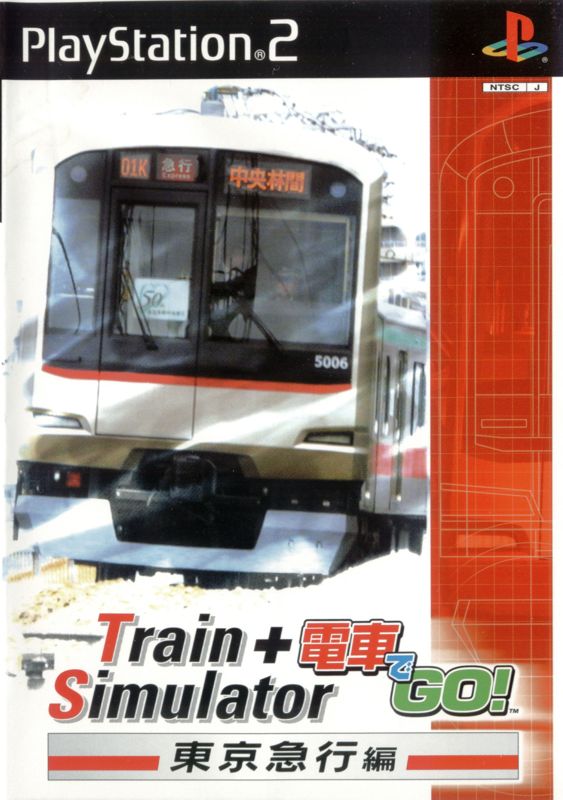Retro Replay Review
Gameplay
Train Simulator + Densha de Go!: Tokyu Line delivers an exceptionally faithful driving experience by combining real-world video footage with detailed train controls. As part of the Japanese Train Simulator series by Ongakun, the game uses videos shot directly from the cab, which means every curve, station approach, and tunnel entrance feels genuine. Players take the driver’s seat in one of seven train types, each modeled with accurate instrumentation and control layouts drawn from official Tokyu Line specifications.
The simulation places heavy emphasis on timetable adherence and safety procedures. You’ll monitor speed restrictions, apply precise braking curves, and engage real-world safety systems such as ATS (Automatic Train Stop). Learning to read and respond to station signals and speed limit boards can be challenging at first, but the included practice modes offer a forgiving introduction before you tackle full-service runs.
Each of the three available routes—the Toyoko Line, Den-en-toshi Line, and Oimachi Line—presents its own operational quirks. Sharp curves on the Den-en-toshi, urban express runs on Toyoko, and frequent station stops on Oimachi reward players who take time to master the subtle differences in traction control and braking performance. Whether you’re managing rush-hour crowds or cruising through suburban scenery at off-peak times, the gameplay loop remains engaging and true to life.
Advanced features like real-time weather variations and day-to-night transitions add another layer of challenge. Rain-soaked rails demand gentler acceleration to avoid wheel slip, while nighttime runs test your ability to read trackside signs under limited illumination. Overall, the gameplay strikes a fine balance between accessibility for newcomers and depth for seasoned train simulation aficionados.
Graphics
Visually, Train Simulator + Densha de Go!: Tokyu Line stands apart by relying on high-definition video footage captured from the driver’s perspective. This approach ensures that landscapes, station platforms, and trackside details appear exactly as they do on the real Tokyu network. From the polished rails glinting in sunlight to the blur of passing scenery at high speed, the graphical realism is simply unmatched by purely 3D-rendered competitors.
Interface elements are cleanly overlaid atop the video feed, providing vital information without obscuring your view. Speedometers, signal indicators, and route maps are sharp and legible, designed to mimic the look and feel of actual Tokyu train cabs. You can customize HUD opacity and layout to suit your preferences, ensuring a clutter-free window into the world outside.
While the footage is largely pre-recorded and devoid of dynamic 3D elements, the game compensates with subtle visual variations. Shadows shift according to the sun’s position, and authentic reflections off carriage surfaces add depth to each scene. Station signage, platform markings, and passenger silhouettes have been faithfully reproduced, lending a documentary-like authenticity that train enthusiasts will appreciate.
On modern hardware, the video streams run smoothly at a consistent frame rate, avoiding the stuttering issues often seen in older rail simulators. Load times between routes are minimal, and resolution scaling ensures crisp visuals even on large screens. In short, the graphics may not be fully 3D-rendered, but the use of real-world footage makes every run feel like you’re broadcasting live from the front cab of a Tokyu train.
Story
As with most train simulators, narrative in Train Simulator + Densha de Go!: Tokyu Line is less about plot and more about the immersive context of real-world rail operations. There isn’t a traditional storyline with characters or cutscenes; instead, the game tells its “story” through the history and rhythms of the Toyoko, Den-en-toshi, and Oimachi lines. Timetables reflect actual schedules, and station announcements use genuine audio to convey a sense of place.
Each line carries its own cultural and operational heritage. The Toyoko Line, linking Shibuya with Yokohama, is a bustling artery of commuter life, while the Den-en-toshi Line snakes through leafy suburbs, echoing the development of Tokyo’s residential outskirts. The Oimachi Line’s mix of local and express services highlights the versatility required of modern rail operators. By driving these routes, players gain a deeper appreciation for the logistical feats behind daily Japanese rail travel.
The seven distinct train models also contribute to the game’s narrative texture. From the sleek EMU sets on the Den-en-toshi to the robust commuter trains on Oimachi, each cab interior feels like an invitation to step into a specific chapter of Tokyu’s network evolution. Small details—like station staff signal flags or platform screen door synchronization—serve as narrative touchpoints that reinforce the authenticity of your journey.
Though there’s no dramatic storyline arc, the evolving challenge of mastering new lines and train types offers its own sense of progression. As you refine your braking technique, learn to anticipate signal changes, and shave seconds off your schedule, you’ll feel a genuine sense of accomplishment—one that mirrors the pride of real train engineers everywhere.
Overall Experience
Train Simulator + Densha de Go!: Tokyu Line is a must-have for rail enthusiasts and simulation purists. Its marriage of real-world video footage and meticulously modeled controls creates an experience that feels both educational and thrilling. Whether you’re a casual player curious about Japanese trains or a hobbyist seeking the most authentic cab simulation available, this title delivers in spades.
The inclusion of official Tokyu data—detailing car behavior, safety systems, and accurate route information—means that every run is more than a game: it’s a virtual training session. The learning curve can be steep, especially when tackling the automated safety systems and precise timetable requirements, but the satisfaction of nailing a perfect on-time run is unparalleled.
Replay value is high thanks to multiple lines, train types, and difficulty settings. You can spend hours refining performance on a single route or hop between Toyoko, Den-en-toshi, and Oimachi to experience entirely different operational challenges. The practice mode is robust, allowing you to isolate tricky segments and master them at your own pace.
Overall, Train Simulator + Densha de Go!: Tokyu Line stands out in a crowded simulation market through its commitment to authenticity and immersion. It may not appeal to players seeking flashy graphics or narrative-driven gameplay, but for those craving a lifelike train-driving challenge—and a front-row view of one of Tokyo’s busiest rail networks—this title is an outstanding choice.
 Retro Replay Retro Replay gaming reviews, news, emulation, geek stuff and more!
Retro Replay Retro Replay gaming reviews, news, emulation, geek stuff and more!




Reviews
There are no reviews yet.